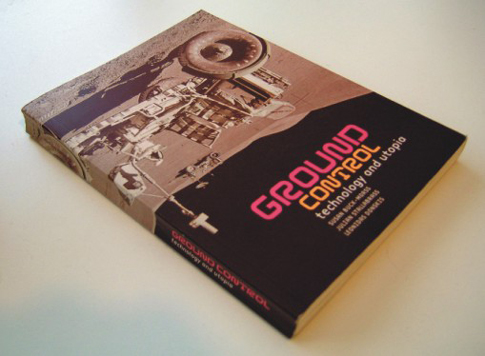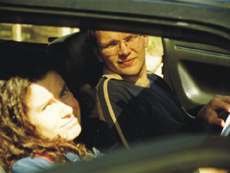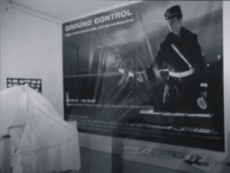Ground Control. Technology and Utopia: a book, website and exhibition; exchange between British and Lithuanian artists, a collaboration between Beaconsfield, London and jutempus, Vilnius / 1995 – 1997
Ground Control to Major Tom;
your circuits dead there’s
something wrong
Can you hear me Major Tom?
Can you hear me Major Tom?
Can you….
– David Bowie, Space Oddity
“It might be worth our while to stay… We’re unlikely learn anything about it but about ourselves…”
– Stanislaw Lem, Solaris
Ground Control is the working title of what has become on ongoing communication between artists in Britain and Lithuania. It is also the name of contemporary art exhibitions in London and Vilnius, a book and a web site.

Communication between Beacosfield in London and jutempus in Vilnius was first established in 1994 and over the ensuing period has involved international travel and negotiations with many and various agencies and people. The original individuals instrumental in putting the two artist-initiated organisations in contact, have since moved on, leaving their mark on the character of this happening which will physically take place over four weeks in Lithuania and Britain, infinitely mutate over time throughout the awesome mechanism of the World Wide Web. having opened up a dialogue, it became apparent that the convential exhibition formula might be inadequate to fully address the cultural context in which contemporary artists in Lithuania and Britain are working. Ground Control, was at one point, the subject of a bid to the European Union which proposed to equip and consolidate the physical and organisational structure of jutempus as the first independen arts initiative in Lithuania, using the exhibition project as its vehicle. The project, though ultimately unsuccessful, was short-listed. However the topicality of developing global communications networks, the historical significance of the opening up of Eastern Europe, the ease of international
travel together with concerns within contemporary art practice about interactivity survived as a potent cocktail for an art project. Furthermore the notion of opening a window between east and west Europe using visual artists as envoys for audiences in their respective countries remained the concept upon which Ground Control developed.
References to early space exploration within the publicity for and title of Ground Control reflect a parallel idealism of purpose, in the face of the unknown. The virtual link with Tyneside is not only related to the shadowy origins of the Baltic Flour Mills, but to its new potential as a flagship for contemporary art. In a cultural climate where an international art language prevails, Ground Control has attempted to avoid the unwieldy transportation of art objects in favour of transporting artists (since the artists are often more interesting), and has unfashionably involved putting faith in the artist as incisive commentator and even seer.
Actively transforming throughout the Ground Control web site, designed by Skyscraper Digital Publishing, links participating organisations and individuals and despatches data to the global internet community. But for most of its participants, Ground Control represents the beginning of an exploration into the unknown territories of the new technologies and new pan-European relationships. As such, the use of ephemeral media in this project has been for the primarily practical purposes of relaying information, rather than of creating polished multi-media artworks.
In Lithuania, artists are used to having the status of highly trained professionals and upholders of cultural life. In Britain artists are more often used to holding the same status as the unskilled and unemployed. The working trips which are an intrinsic part of the participating artists’ brief, and in which they become cultural tourists, present dilemmas. British visitors to Vilnius might that habitual thirst for new experience makes proximity of an unsafe nuclear reactor to the historic heart of Lithuania as exciting as the city’s distressed physical beauty: while Lithuanian visitors to London might be initially deceived by the veneer of functionality and affluence. One of the features of the long development period for Ground Control, has been the discovery of just how difficult international communication can be and how little real interest there seems to be in changing this situation. The Ground Control artists, as audiences on both sides of Europe might choose to inspect the other, or failing that, themselves.






How could we make those places to be visible in order to re-discover them. In the best eastern tradition trying to show, to unfold the country and taking by car visiting artists around we re-discover and re-consider our environment and find our own ways to re-present it.
We made a several trips to the many of abandoned places, gypsies, Center of Europe, car mechanic garage, biggest black market, car junk and other under-represented places together with Lucy Gunning, Robin Rimbaud aka Scanner, Jon Thomson & Alison Craighead during April – June, 1997.
CHRONOLOGY:
Wednesday 1.6.94 at 16.00hrs Gediminas Urbonas meets Tracey Warr on the coastal steamer from Bodo to Stamsund in Northern Norway. Saulius Grigoravicius, Liutauras Psibilskis and Anders Kreuger are on board.
Thursday, 26.8.94 at 22.00hrs TW travels to Vilnius by train and visits Stalin and Lenin’s graveyard
Friday, 11.12.94 at 18.00hrs LP and AK meet Beaconsfield in London. AK invites Naomi Siderfin and TW to Helsinki’s Ars’95 via Lithuania
Tuesday 9.2.95 at 2.00hrs TW and NS meet the Lithuanian art world in force on a two day bus journey from Vilnius to Helsinki.
NS is seeking reciprocal partners for an art project. TW, Beaconsfield and Jutempus decide to collaborate.
Spring 1995
Based on a discussions which took place on coastal steamer, in Coach & Horses pub and on bus, in Vilnius, Helsinki and London, Beaconsfield and TW make a proposal to Jutempus entitled Ground Control – artists despatches from Lithuania and Britain, and apply for funding.
Friday 28.6.95
SG visits London and Gateshead. In Newcastle’s Baltic cafe, he orders Lithuanian piggy ears and a pint of Beck’s and remembers his army days as he sleeps on a floor to allow TW and NS the mattress.
Friday 13.10.95
Beaconsfield opens a new venue in London.
Sunday 17.11.95
David Crawforth and TW visit Vilnius to meet Lithuanian artists, funders and sponsors. DC gets locked all night in a toilet in Tallinn.
Tuesday 4.7.96
GU visits London to meet Beaconsfield, TW, Black Dog Publishing and Mute; to see the Queen and Nelson Mandela on the Mall, Lady Margot Maxwell Macdonald and others.
Autumn 1996
Major proposal made to the European Union PHARE fund, to equip and consolidate Jutempus as the first independent arts organisation in Lithuania, using Ground Control as a vehicle, is rejected. Re-budget.
Friday 11.4.94
NS travels with Julian Stallabrass to finalise details. Meetings take place in Contemporary Art Centre cafe with coffee, cognac and Lolita Jablonskiene translating. They access the internet at Digital Masons.
Wednesday 16.4.97 at 21.30 hrs
First British artist – Scanner – arrives in Vilnius with Lithuanian Airlines. Meets members of IPOJ and Patron of Jutempus.
Buys rye bread for his mother in London.
Saturday 3.5.97
Lucy Gunning arrives in Vilnius with super 8 camera following the election of the labour government in Britain since the ’70’s…
